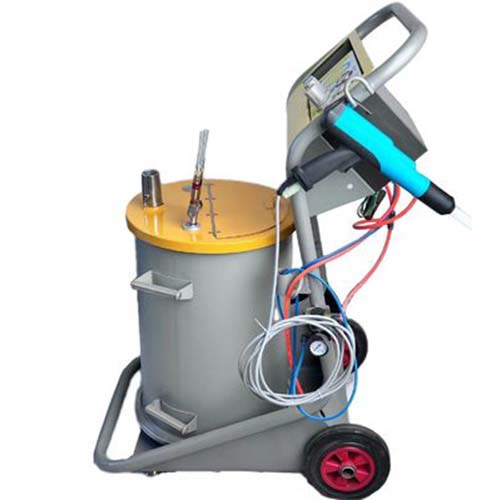Portable Powder Coating Machine gains popularity among DIY enthusiasts, small workshops, and mobile technicians. Its compact design fits tight spaces and on-site jobs. Prices start at $900 for entry-level hobby kits, $2,500–$6,000 for mid-tier models with better portability, and $10,000+ for professional-grade units with rugged builds and extended battery life.

Portable Powder Coating Machine coating projects thrive on mobility, handling items that can’t move. Examples include coating outdoor metal furniture in backyards, repairing farm equipment in fields, and customizing motorcycle parts in home garages. Its small size lets users work around the item, avoiding heavy lifting. Finishes resist moisture and wear, making projects last longer than with spray paint.
Portable Powder Coating Machine coating surface treatment technology focuses on simplicity for on-the-go use. Start by wiping surfaces with a degreasing cloth to remove oil. Use a portable wire brush or mini sandblaster to strip rust—tools small enough to carry with the machine. For tough grime, apply a water-based cleaner and rinse, then dry thoroughly. This preps surfaces so powder adheres tightly, critical for the machine to deliver smooth results.
Portable Powder Coating Machine is a lightweight, movable device that applies electrostatically charged powder to surfaces. It’s designed for users needing flexibility—too small for large factories but perfect for garages, job sites, or home workshops. The powder sticks to grounded metal (or conductive materials) and cures with heat, often from a portable oven or heat gun. Its compact parts fold or detach, fitting into car trunks or storage closets.
Ergonomic Spray Gun – Lightweight, with a grip designed for long use. Delivers charged powder, with knobs to adjust flow and charge strength. Small enough to reach tight spots like bike frame corners.
Detachable Powder Reservoir – Holds 1–5 pounds of powder, enough for 2–3 small projects. Transparent sides let users check levels, and a quick-release latch makes refills easy.
Compact Control Box – Powers the gun and charge system, with a handle for carrying. Most plug into 110V outlets; premium models have rechargeable batteries for off-grid use, boosting portability.
Portable Powder Coating Machine advantages include unmatched mobility—no need for a fixed workshop. It costs less than industrial machines, making powder coating accessible to hobbyists. Setup takes minutes, unlike large systems that need installation. Its size suits small items, reducing overspray waste. Many models work with multiple powder types, from matte to metallic, adding versatility for creative projects.
To choose a
Portable Powder Coating Machine for DIY projects, prioritize weight—under 15 pounds is easy to move. Look for a spray gun with simple controls (like one-button operation) to avoid confusion. Check the reservoir size: 2–3 pounds fits most home projects, reducing refills. Ensure it pairs with a portable curing tool (like a 1500W heat gun) sold separately or included. Read reviews for durability—plastic parts may crack; metal components last longer.
Setting up a
Portable Powder Coating Machine in a small garage starts with clearing a 4x4 feet space. Place a grounded metal table for workpieces—attach a ground wire from the table to a metal stake in the floor. Unfold the machine, connect the spray gun to the reservoir, and plug in the control box. Test the charge by spraying a scrap metal piece—powder should stick evenly. Hang a plastic sheet around the area to catch overspray, keeping the garage clean.
Fixing clogging in a
Portable Powder Coating Machine spray gun starts with turning off the machine. Remove the nozzle and soak it in warm, soapy water for 10 minutes to dissolve dried powder. Use a small brush (like a toothbrush) to scrub the nozzle holes. Check the reservoir: if powder is clumpy, sift it through a fine sieve into a clean container. Reassemble the gun, test with a small spray—consistent flow means the clog is gone.
Ensuring even curing with a
Portable Powder Coating Machine requires monitoring temperature. For small items, use a heat gun: hold it 6–8 inches from the surface, moving constantly to avoid hot spots. For larger pieces, use a portable oven—preheat to 400°F, place the item on a rack, and set a timer (15–20 minutes for most powders). Use an infrared thermometer to check surface temp—350–450°F ensures proper melting. Let cool naturally; don’t quench with water.
Cleaning a
Portable Powder Coating Machine after use prevents residue buildup. Empty leftover powder from the reservoir into its original container—seal tightly to keep moisture out. Wipe the reservoir with a dry cloth to remove dust. Disassemble the spray gun: wipe the barrel with a lint-free cloth, and use compressed air to blow out any powder in the nozzle. Wipe the control box with a damp cloth (avoid water on plugs). Store all parts in the machine’s case to protect from dust.
Links:Powder Coating Machine,Powder Coat Machine,Powder Coating Machine For Sale,Electrostatic Powder Coating Machine,Portable Powder Coating Machine,Powder Coating Line Suppliers,Powder Coating Line Manufacturers,Powder Coating Line,Powder Coat Curing Oven,Industrial Powder Coating Ovens,Small Powder Coating Ovens,Powder Coating Oven Manufacturers,Industrial Powder Coating Equipment,Powder Coating Equipment,Industrial Powder Coating Booth,Homemade Powder Coating Booth,,Diy Powder Coating Booth,Powder Coating Spray Booth,Powder Coating Booth
 Leave us message
Leave us message

